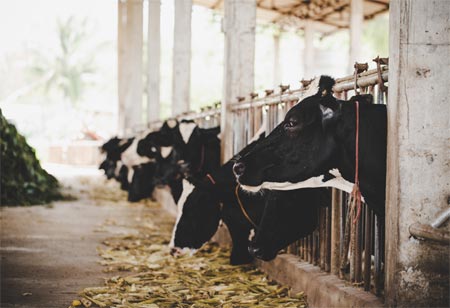
India’s population is increasing giving rise to a burgeoning middle class. An increase in per capita income is linked to increases in the consumption of protein. Since milk and milk products are the most important source of protein in India, we can assume that dairy consumption will increase significantly. India would go from being a net exporter of milk to an importer given that domestic demand may exceed supply. The demand for milk is likely to be 270 million tons amount of milk by 2030.
In order to close the supply gap and increase production, there will be an increased pressure on limited resources such as land which can be either used to grow cereals, vegetables for human consumption vs growing fodder for dairy animals. Land under fodder cultivation has not grown, though there has been considerable growth in the animal population in the last few decades.
The best solution to tackling sustainability in dairy farming is to increase productivity and overall milk production without a proportional increase in the number of animals. India has the highest bovine population, but our productivity is not as high as some of our western counterparts. The way forward to sustain the growth in milk production is to increase milk per animal so that we have fewer animals to feed.
This increase in productivity can be brought about by increasing the genetic potential of existing animals and adding genetic gains to future generations through the use of artificial reproductive technologies such as artificial insemination and embryo transfer technologies. Poor genetics of the herd results in lower milk productivity. Artificial insemination using high merit semen doses which are from progeny tested animals can improve milk production by increasing milk production of the offspring.
IVF technologies ensure 100% genetic gains in offspring which also provides a dairy farmer with assured revenues. The quality of these services needs to improve with better training, infrastructure, and streamlining by making these services available to the farmer at their doorstep.
Apart from increasing milk yield from each animal, it is important to also reduce the number of non-productive animals (males) and change the ratio of productive animals in the cattle population. Sexed semen doses ensure a female calf through sperm sorting technology by separating X chromosome material from Y chromosome material. This has two-fold benefits. It ensures that scare feed and fodder is given only to productive animals, enhancing protein feed conversion, and also can solve the stray cattle issue abandoned animals can wreak havoc on agricultural land. Moreover, a farmer will receive higher monetary benefits from a female calf.
There are several dimensions to environmental sustainability in dairy farming including greenhouse emissions, water use, land use, biodiversity, etc. The livestock sector represents 14.5% of human-induced greenhouse gas emissions (GHG). Cattle are responsible for 150 metric tonnes of greenhouse emissions every year.
Reduction in greenhouse gases can occur in all stages of production, but the biggest reductions will occur through changes in farm management. Using high merit semen doses and sexed semen alone can lead to large reductions in methane emissions. A lower cattle population will not only help reduce environmental footprints through lower greenhouse emissions but also reduce pollution caused by farm runoff and reduce land usage and lower water footprints as well.
Innovative technologies also play a role in social and economic sustainability. With increased productivity, there will be more rural employment as there will be more dairy farms that employee more people, which will have a positive effect on the rural economy. This will lead to our national goal of doubling rural farmer income.
Achieving sustainability in the dairy industry will take innovation, science, and technology to create breakthroughs and commitment from big dairies, corporations, government as well as educated informed customers
Protecting the environment goes hand in hand with supporting the livelihoods of the 70 million dairy farming community in India. 90% of the dairy farmers in India are marginal farmers and have less than 2 cows and 70% of the farmers are women. Dairy farmers, in general, are committed to raising animals sustainably and one-way corporations and governments can support their mission through supporting innovations that enhance farm productivity and improve animal welfare, reduce carbon emissions, water use, and labour.
Post farm dairy also needs a technology revolution for sustainability. Minimizing the carbon footprint at commercial dairies will need a commitment to source clean energy to improve efficiency in key manufacturing processes and equipment. Improving energy efficiency, eliminating single-use plastic when possible, and increasing recycling is all important aspects.
Therefore achieving sustainability in the dairy industry will take innovation, science, and technology to create breakthroughs and commitment from big dairies, corporations, government as well as educated informed customers.
We use cookies to ensure you get the best experience on our website. Read more...